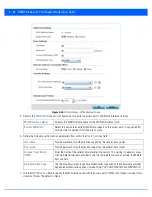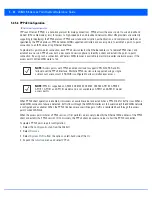
5 - 74 WiNG 5.6 Access Point System Reference Guide
16. Define the following
Rate Limit
settings for the L2TP tunnel configuration. Rate limiting manages the maximum rate sent
to or received from L2TPv3 tunnel members.
Establishment Criteria
Configure establishment criteria for creating a tunnel between the device and the NOC.
This criteria ensures only one tunnel is created between two sites where the tunnel is
established between the vrrp-master/cluster master/rf-domain manager at the remote
site and the controller at the NOC. The tunnel is created based on the role of the remote
peer.
•
always –
The tunnel is always created irrespective of the role of the local device.
•
vrrp-master
– The tunnel is only created when the local device is a VRRP master.
•
cluster-master
– The tunnel is only created when the local device is a cluster master.
•
rf-domain-manager
– The tunnel is only created when the local device is a RF-Domain
manager.
In all the above cases, if the local device goes offline for any reason, the tunnel is brought
down.
VRRP Group
This field is enabled only when the
Establishment Criteria
is set to
vrrp-master
. Use the
spinner to select the VRRP group.
Critical Resource
Enter the critical resources required for creating and maintaining a L2TPV3 tunnel. A
tunnel is only established when all critical resources for the tunnel to be operational are
available at the time when the tunnel is created. If any one of the listed critical resources
goes down, the tunnel is disabled.
When a tunnel is established, the listed critical resources are checked for availability.
Tunnel establishment is started if the critical resources are available. Similarly, for
incoming tunnel termination requests, listed critical resources are checked and tunnel
terminations are only allowed when the critical resources are available.
For more information on managing critical resources, see
Profile Critical Resources on
page 5-165
.
Session Name
Use the drop-down menu to select the tunnel session that will have the direction, burst
size and traffic rate settings applied.
Direction
Select the direction for L2TPv3 tunnel traffic rate limiting.
Egress
traffic is outbound
L2TPv3 tunnel data coming to the controller, service platform or access point.
Ingress
traffic is inbound L2TPv3 tunnel data coming to the controller, service platform or access
point.
Maximum Burst Size
Set the maximum burst size for egress or ingress traffic rate limiting (depending on which
direction is selected) on a L2TPv3 tunnel. Set a maximum burst size between 2 - 1024
kbytes. The smaller the burst, the less likely the upstream packet transmission will result
in congestion for L2TPv3 tunnel traffic. The default setting is 320 bytes.
Rate
Set the data rate (from 50 - 1,000,000 kbps) for egress or ingress traffic rate limiting
(depending on which direction is selected) for an L2TPv3 tunnel. The default setting is
5000 kbps.
Background
Set the random early detection threshold in % for background traffic. Set a value from 1
- 100%. The default is 50%.
Best-effort
Set the random early detection threshold in % for best-effort traffic. Set a value from 1 -
100%. The default is 50%.
Summary of Contents for WiNG 5.6
Page 1: ...Motorola Solutions WiNG 5 6 ACCESS POINT SYSTEM REFERENCE GUIDE ...
Page 2: ......
Page 22: ...8 WiNG 5 6 Access Point System Reference Guide ...
Page 26: ...1 4 WiNG 5 6 Access Point System Reference Guide ...
Page 38: ...2 12 WiNG 5 6 Access Point System Reference Guide ...
Page 74: ...3 36 WiNG 5 6 Access Point System Reference Guide ...
Page 468: ...6 2 WiNG 5 6 Access Point System Reference Guide Figure 6 1 Configuration Wireless menu ...
Page 568: ...6 102 WiNG 5 6 Access Point System Reference Guide ...
Page 614: ...7 46 WiNG 5 6 Access Point System Reference Guide ...
Page 660: ...8 46 WiNG 5 6 Access Point System Reference Guide ...
Page 716: ...9 56 WiNG 5 6 Access Point System Reference Guide ...
Page 730: ...10 14 WiNG 5 6 Access Point System Reference Guide ...
Page 982: ...14 20 WiNG 5 6 Access Point System Reference Guide ...
Page 984: ...A 2 WiNG 5 6 Access Point System Reference Guide ...
Page 1046: ...B 62 WiNG 5 6 Access Point System Reference Guide ...
Page 1047: ......






























